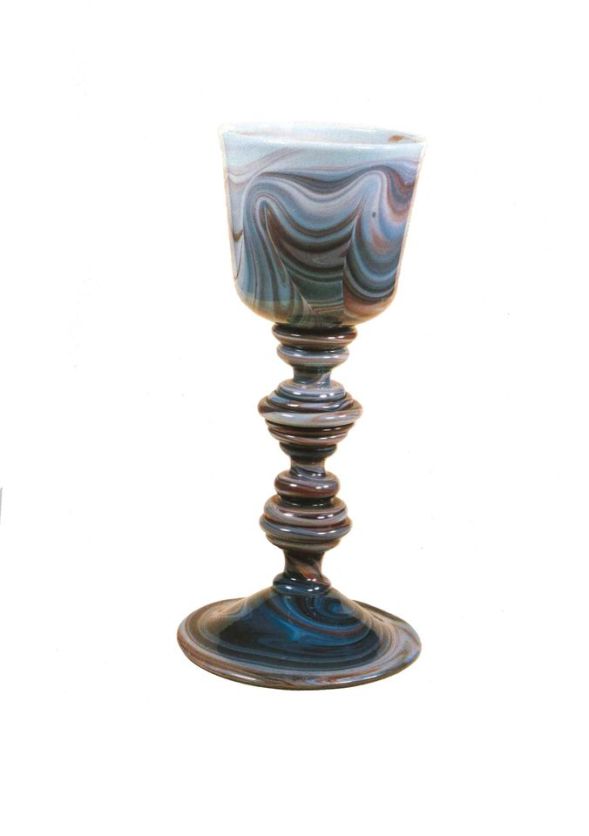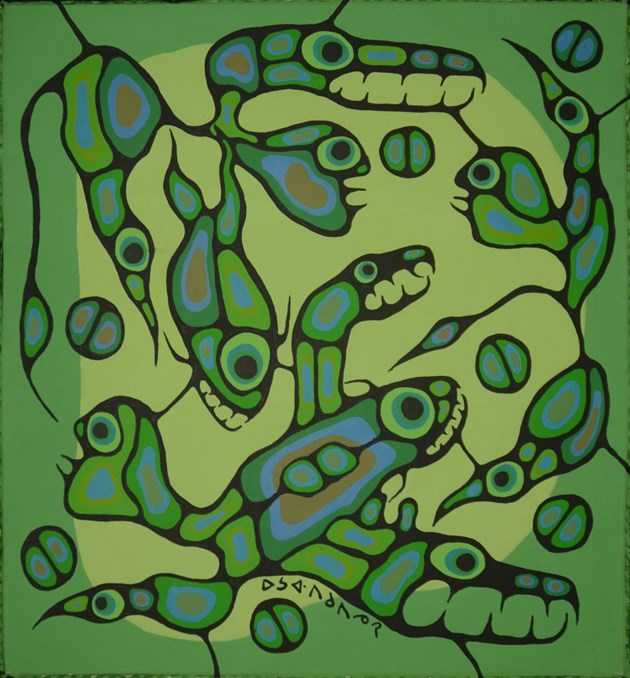German museum and auctioneer Im Kinsky tussle over looted glass goblet
https://www.theartnewspaper.com/news/museum-auctioneer-tussle-over-looted-goblet

German museum and auctioneer Im Kinsky tussle over looted glass goblet
Object was returned to consigner not museum from where it was looted at the end of Second World War
CATHERINE HICKLEY – June 6, 2018

A multicoloured marbled glass goblet dating from around 1800, which was stolen at the end of the Second World War, is the subject of a dispute between the Vienna auction house Im Kinsky and Berlin’s Märkisches Museum.
The museum bought the goblet at auction in 1890 along with eight similar glass objects, all of which were looted in the chaos at the end of the war. Little was known about the goblet’s history until it was offered for sale at the Glasgalerie Michael Kovacek in 1990, according to Im Kinsky’s lawyer Ernst Ploil, on consignment for a German seller. The museum tried to recover the glass at that time, but Kovacek failed to stop the sale.
The goblet surfaced again this year at Im Kinsky in Vienna, where Kovacek and Ploil are managing partners. In the catalogue for the auction on 25 April, the provenance history included the brief description “Museum Berlin”.
At the request of Ulf Bischof, the Berlin lawyer representing the Märkisches Museum, Im Kinsky withdrew the goblet from the auction and returned it to the consignor. The museum then offered to pay a “finder’s reward” of €5,000 to avoid a legal battle but the consignor rejected the offer, saying he had another potential buyer who was offering €48,000.
“Our client is deeply concerned by this behaviour,” Bischof says. “It is unprecedented that an auction house knowingly accepts a stolen museum work on consignment and uses a cryptic ‘Museum Berlin’ provenance for advertising.
“Collectors as well as the museum community should be alerted to such questionable business practice.”
Bischof says the goblet was produced at Zechlinerhütte, a former glass-making centre in Rheinsberg, north of Berlin.
It is not known exactly how it came to be lost in the Second World War, but many Berlin museums stored their collections in bunkers and other bomb-proof locations to protect them from air raids. Some of these stored treasures were plundered by the Red Army; others were looted by ordinary German citizens.
Ploil argues that statutes of limitations would hinder any efforts by the museum to pursue its claim in court and that the previous buyers bought the goblet in good faith, thereby obtaining legal title.
“The fact that the goblet was previously in the museum was known, but no one knew it was stolen,” Ploil says. “Any restitution claim for this has expired.”
Bischof says that the Märkisches Museum still holds legal title. He insists that whoever buys it now cannot claim a good-faith purchase because the seller is aware of its tainted past. Any attempt to sell the goblet without informing the buyer in full of the ownership claim may be liable for fraud, he says.
Bischof also argues that even though the theft itself is time-barred under statutes of limitation, laws against concealing stolen goods are still applicable. He has informed Austrian law enforcers.
Court dismisses claim that Norval Morrisseau painting is fake

Court dismisses claim that Norval Morrisseau painting is fake

TORONTO — In a case that has been watched closely by the art world, a Superior Court justice has ruled that, “from the law’s point of view,” a painting sold by an Ontario art gallery to Kevin Hearn of the Barenaked Ladies is “a real Norval Morrisseau painting.”
The judge also found that the evidence he heard did not “in any conclusive way” connect Spirit Energy of Mother Earth to an alleged fraud ring in the Thunder Bay area that produced Morrisseau fakes.
“Counsel for Hearn went to considerable effort in gathering evidence and calling witnesses to establish that a group of fraudsters worked for a number of years in northwest Ontario, and that as a consequence of their prolific activities a substantial number of Morrisseau forgeries exist,” Justice E.M. Morgan noted in his Reasons for Judgment, issued last month.
He noted, however, that “no witness identified this particular painting as having been produced by a member of the northern Ontario-based criminal enterprise.”
Hearn, keyboardist with the Barenaked Ladies band, sued Toronto’s Maslak-McLeod Gallery, alleging the work he bought in 2005 was counterfeit.
During the civil trial that concluded in February, the court heard from an art expert who has studied Morrisseau’s work extensively. She concluded the piece was an imitation as it contained numerous elements that were different from Morrisseau’s standard approaches.
However, an expert in handwriting analysis testified that, with “reasonable certainty,” he believed Morrisseau’s signature on the painting was authentic.
In his written Reasons for Judgment, issued on May 24, Justice Morgan noted how some of the testimony illustrated “the most fundamental problem in attempting to authenticate a purported Norval Morrisseau painting: there is more than one Morrisseau, or more than one Morrisseau style, that can emerge or submerge at any time.”
The judge said Spirit Energy of Mother Earth—is one more painting “that is possibly an authentic Norval Morrisseau and possibly not. As a matter of law, what is important is that a tie goes to the Defendants. Where a court is left in doubt because the relevant burden of proof has not been satisfied, the ‘fact’ sought to be proved is in law not true.”
Morrissesau, born in 1932 on the Sand Point Reserve near Beardmore, is credited with originating the Woodland School of Indigenous art.
He died in 2007.
Kraemer brothers among six charged over allegedly fake Louis XIV furniture

Kraemer brothers among six charged over allegedly fake Louis XIV furniture
Laurent and Olivier Kraemer charged with organized fraud and money laundering in an ongoing investigation over so-called “fake Boulles”
VINCENT NOCE – May 21, 2018

Laurent and Olivier Kraemer, of Paris’s venerable Kraemer Gallery, are among a group of six dealers, experts and cabinet makers that have been charged with organized fraud and money laundering in a French court. The indictments—announced in January but only recently reported—mark the culmination of a multi-year investigation into allegedly fake Louis XIV furniture.
Others charged include Jacques Poisson a retired cabinetmaker, and his wife Colette; Michel Rocaboy, a cabinetmaker who was the Poissons’ sub-contractor, and Roland de l’Espée, a dealer and the former president of the French Friends of Versailles Society. All proclaim their innocence.
In 2016, the French art crime unit (OCBC) started an investigation into a rash of scandals that have rocked the antiques trade. The same year, Laurent Kraemer was charged in a separate criminal investigation regarding a series of fake chairs, most of which were sold to Versailles. Bill Pallot, a specialist in seated furniture at Didier Aaron & Cie (now run by Hervé Aaron), admitted fabricating around ten of them with Bruno Desnoues, a cabinetmaker employed by the château. Both spent four months in jail awaiting trial— a date has still not been fixed. In 2016, Aaron’s gallery was expelled from the Biennale des Antiquaires, and the Kraemers withdrew.
The new criminal proceedings involving the Poissons’ workshop centers on around 20 suspect pieces offered for sale or sold to collectors in London, Monaco, and New York. One of the civil parties, a Monaco-based Italian collector, has also begun a civil court action against the Kraemer Gallery over 13 pieces of Louis XIV and Louis XV furniture and objets d’art, purchased for €13.5m.
On 9 January, the Kraemer brothers were taken into police custody for two days, then charged by the judge overseeing the criminal investigation. They were later released on a bail of €4.5m and €1m respectively.
On 24 January, Roland de l’Espée was indicted for attempting to sell, for around €10m, a commode attributed to Alexandre Jean Oppenordt, and supposedly commissioned by the brother of Colbert, Louis XIV’s prime minister. The criminal investigation opened on 19 December 2016 and led to the discovery of more suspect pieces, including a pair of Boulle cabinets, sold by the Kraemer Gallery in 1999 to Axa for an estimated €6m.
Jacques Poisson’s daughter, Marie-Helene, denies any involvement by her family and says they “had never sold furniture” and “never had the means” to make such pieces. She says her father is not well enough to answer any questions.
Laurent Kraemer denounces “a judicial and media storm in a teacup, based on only one analysis”, which he contests. “There has been no judicial expertise for this investigation”, he says. The gallery says the case is a “settling of accounts” among dealers and suggests that the criminal procedure is essentially a financial matter. Payments of millions of euros led police to bank accounts in Switzerland and Singapore and off-shore companies. Also dismissing the suspicions of money laundering, the family claims to be the victim of a campaign aimed at undermining its reputation.
